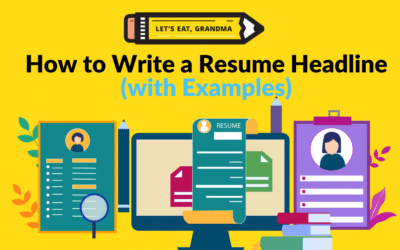Editor’s Note: This post is updated yearly for accuracy and relevance.
The new year is a time for reflection and reassessment — the perfect time to take a look at your resume and see what you can update.
Not only are you reflecting on the previous year and everything you’ve accomplished, but you may also be reassessing your short- and long-term goals.
Even if you aren’t looking for a new position or industry change, it’s still smart to update your resume on a regular basis. It makes things easier when you actually need it, so you’ll be ready to apply the moment you find the perfect job description or make the right connection.
Not sure you need to update your resume? Submit it for a free resume critique from Let’s Eat, Grandma!
Tips for your yearly resume update
If you’re ready to embrace the possibilities and prepare for the new year, here are a few quick and easy suggestions to give your resume a full refresh.
1. Add recent metrics that showcase your impact

Photo by Hannah Olinger on Unsplash
You did a lot in 2024. It’s likely that you finished more projects or closed more deals than you even remember. Take a moment to review your accomplishments from the last year, then add those metrics and results to your resume while they’re still fresh in your mind. Don’t be afraid to consult with a coworker to go over any helpful details you may have forgotten.
The most effective way to update your resume is to use metrics. Metrics are incredibly useful because they show a lot of your impact in your position without taking up much of the page. They quickly show busy recruiters that you are capable of accomplishing a lot for the benefit of a company and are actively growing (or have grown) in your position.
Some examples of metrics include accounts you’ve grown, revenue you’ve incurred for the company, or new hires you’ve trained. Before you type up your experience, look at the description of a job posting you are interested in. This will help you tailor your experience to the ideal position for you and distill your most relevant attributes.
For example, let’s say you led the installation of a new software that improved efficiency in your department. You could simply write:
-
Installed (name) software that improved efficiency in the department by 25%.
But this doesn’t offer any details about your specific role in the process. Alternatively, you can use this to show a potential employer your skills, such as your ability to identify inefficiencies and growth opportunities, see projects through from start to finish, and train coworkers and new hires on it to achieve a percentage of increased operations or revenue.
-
Identified department inefficiencies and implemented, oversaw, and trained team members on (name) software to increase efficiency in the department by 25%.
Metrics clearly and succinctly show your contributions and their direct results. Remember to keep it short and sweet, but focus on the important bits: what you did, how you did it, and what it accomplished.

Photo by Branko Stancevic on Unsplash
2. Update the skills section
When you update your resume, be sure to pay special attention to the “skills” or “areas of expertise” section. The skills section is important for applicant tracking systems (ATS) to process you through, otherwise you may get thrown out of the digital ring before you even hit a recruiters desk.
There is a balance between “keyword stuffing” and making sure all of your relevant skills are listed on your resume. First, remove skills you wouldn’t want to use in a new job, such as remedial skills or advantages that only apply to a small scope of work. For example, if you used to work with customers but now specialize in internal communications, you don’t need to keep “customer service” on your updated resume. Remove any outdated or repetitive skills that are taking up space without adding value to your professional history.
Instead, focus on skills that apply to a job search you would be interested in. Take a look at some job descriptions and pick out the preferred and required skills that fit your experience. Don’t forget to add skills you learned over the past year (or years, if you haven’t updated your resume recently.)
Additionally, be sure to focus on hard skills. These will help you stand out from the crowd the most as they are highly specific and pivotal to success within the job. For example, if you were applying to be an accountant, the first skill a recruiter is looking for isn’t your verbal and written communication qualities. The first thing they will look for is financial reporting and planning skills. Only once they have gathered all the applicants with the required hard skills will they start to examine the soft skills to see which one is the best fit for their company.
Remember: hard skills first, soft skills second.
3. Add new certifications and licenses
If you have earned any certifications, licenses, or degrees since you last updated your resume, it’s time to add them. Make sure you add the year you received them, or the year it will expire if applicable. If any of your new certifications or degrees come with a title, such as MBA or PMP, you can add this next to your name on the header of your resume.
Industry certifications and licenses are investments you make into your skill set and your career, and they show that you are dedicated to ongoing improvement. Don’t let them get buried in your updated resume, or worse, forgotten!
4. Modernize the format and structure
If you haven’t updated your resume since 2001, chances are it’s double-spaced, in Times New Roman. It’s time to clean it up to a modern look that is crisp, concise, and pleasing to the eye.
Even if it hasn’t been that long since it was last updated, it could probably still use a formatting polish. Maybe you fell prey to the skills chart fad, or added a graphic to your resume to make it look cool. It’s tempting to show your personality through an intricate and unique resume design, but these can hurt your chances of finding a position more than they can help. Instead, use other documents and platforms (such as a cover letter, a LinkedIn profile, or an online portfolio) to show your character while keeping your updated resume clean and ATS-compatible.
Additionally, if you still have an Objective statement, it’s time to swap it out for a summary. Professional summaries offer a brief outline of who you are and what you can bring to a company. It’s especially useful if you are switching industries, as it gives you the opportunity to show your relevant skills and experience upfront.
5. Ask someone else to take a look

Photo by LinkedIn Sales Solutions on Unsplash
Finally, once you’ve spruced up your resume, it’s a good idea to have someone you trust (such as a friend, coworker, or family member) to read your resume. It’s your first impression to a potential employer, after all – you wouldn’t want an overlooked typo or misspelling to get in the way.
Try to find someone who is familiar with the industry you are applying to. If you’re staying in the same sector, this will be simple, but you may have to look a little harder to find someone knowledgeable. If you can’t find someone within your professional realm, try to find someone you know frequents the job search space or is familiar with modern recruiting methods.
If all else fails, just having someone to look over your wording and grammar can be a big help. Even someone who isn’t aware of industry nuances can point out an intelligible sentence, a repetitive phrase, or an incorrectly used word. Every document needs another set of eyes to nitpick the details that can be the difference between an interview request and an unanswered application.
Alternatively, you might also consider requesting a free critique from Let’s Eat, Grandma to discuss your updated resume with an expert who can help you navigate ATS and focus on the right keywords for your job search.
Beyond the resume: What else should you update?
Congratulations, you have now updated your resume for 2025! But if you really want to kill the job search game, there’s a bit more to think about.
This article is about your resume, but while you’re at it, why not spruce up your other professional assets? Take a look at your LinkedIn profile to make sure all your latest skills are added, and that your professional summary is concise and up to date. Add a reference to your list of professional references, or any new projects to your portfolio. You can even create a basic cover letter outline that showcases your most recent accomplishments so you have it ready to go at a moment’s notice.
With a host of quality professional documents on your side, you’re a shoo-in for your next best position yet.
Ready for more job search help?
Sign up for a free Senior Writer Resume Critique to see what’s holding you back from landing interviews. One of our top professional resume writers will give you personalized feedback on the top 3 items you can improve based on our expert practices!




